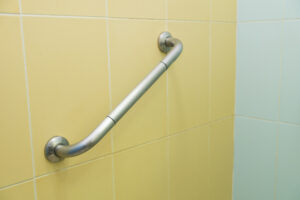Regarding home safety, some things are simply non-negotiable, and one of those critical factors is understanding where and how to install bathroom grab bars. Whether you’re planning for the future or looking to make your bathroom more accessible right now, knowing the facts about these fixtures is crucial.
Join us on a journey through the ins and outs of toilet room grab bars – from pinpointing the suitable locations to understanding the essential measurements. We’re here to provide reliable, fact-based guidance to ensure your toilet room becomes a safe haven for everyone who uses it. Safety always comes first, and with this guide in hand, you’ll be well-equipped to make your toilet room as secure as can be. So, let’s dive into it together!
Contents
Best Guide for Proper Placement of Bathroom Grab Bars
Safety when using the bathroom should be our topmost concern. Especially when we’re getting old, or when we are taking care of our elderly loved ones. Keeping that in mind, having a grab bar in your bathroom is essential, especially when considering the importance of grab bar angle. You should know where the best angled grab bar placement is for shower grab bars. If you want to provide a safe space for yourself or your elderly loved ones, please read on.
What Are Grab Bars?
A grab bar or, should I say, mount grab bar, is a metal safety bar that is graspable, which helps maintain the balance and stability of a person while standing or when they stand up from a sitting position in various settings, such as a shower stall. Put grab bars are assistive devices to help a person mount grab bars from standing up and sitting down.You can put it in or have toilet grab bars in your shower room, It can be a straight grab bars or in a vertical grab bar placement.
Grab Bar Placement: Where to Place Grab Bars
Grab bars, being assistive devices, can be placed in the shower, bathtub, toilet, and even other areas of your home where assistance is needed. Another benefit of grab bars is that it provides added support for people who are standing from a seated position or for people who are trying to sit down.
Importance of Using Grab Bars
An article published by the CDC stated that 21.8 million aged over fifteen years and above sustained non-fatal injuries, accounting for $67.3 billion in lifetime medical costs. While further research shows that for older people aged 65 years and above, falls account for 60% of injury-related emergencies and 80% of falls in the bathroom.
Although the best grab bars for seniors might be something that looks like an eyesore in your living space, bathroom grab bars are a must for us or the older adults in our family, especially in areas like the bathroom where slipping and falling are more common than in any other area in the household. Installing bathroom grab bars in strategic bathrooms will ensure that there will be something to hold on to when you are trying to get up from the bathtub or sitting on the toilet. This added safety measure of bathroom grab bars for seniors can prevent accidents and provide peace of mind for everyone using the bathroom.
Another importance of using a grab bar is that it helps lessen fatigue from standing for long periods and enhances safety by properly placing grab bars around the toilet.
Overall, installing grab bars in your living space will give additional stability.
Kinds of Grab Bars
The different kinds of grab bars listed below will help you choose and install grab bars, the perfect type for your personal needs and preferences. Knowing the type of grab bar also ensures the utmost safety. Please read carefully through the kinds of grab bars listed below for the best placement of grab bars.
As to Placement:

Vertical – A vertical grab bar, also known as a vertical bar, is in an upright position. Meeting specific vertical grab bar requirements is crucial for ensuring safety and accessibility, especially in spaces like bathrooms or areas with mobility challenges. These requirements often dictate the height, strength, and placement of the vertical grab bar. Typically, vertical grab bars are constructed from durable materials such as metal or very durable plastic to meet these standards.

Diagonal – A diagonal grab bar should at least be 24 inches in length and help stand up from a seated position.

Horizontal – Horizontal wall grab bars are usually near toilets since they offer more stability in standing up.
As to Installation:

Suction Grab Bars – Suction grab bars are easy and cheap to install, but I do not recommend using them for showers, especially when considering tub shower grab bar placement. The reason for this is that through time, the suction will loosen depending on your weight, the surface to which it is attached, and the period of use of these grab bars. Suction grab bars may work in certain situations; however, the risks of using this type of grab bar, especially in critical areas like tub shower grab bar placement, outweigh the benefits.

Wall-mounted Grab Bars – Wall-mounted grab bars are ideal for every household since they can carry almost any weight. Another benefit of well-mounted grab bars is that they last very long. Attach grab bars in critical areas of your home to enhance safety.
As to Kind:

Metal Grab Bar – The most popular grab bars are stainless steel and chrome grab bars. Stainless steel and chrome grab bars are popular from a safety and aesthetic standpoint. Regarding the former, metal grab bars are safer since they are usually drilled into the walls. Another benefit is it is easy to clean and maintain. On the latter aspect, many prefer metal grab bars since they have a clean and polished look.

Plastic Grab Bar – Plastic grab bars are the less known type of grab bars, and rightfully so. Although cheaper than metal grab bars, these grab bars do not last long and have lesser load capacity.
Now that you are familiar with the different types of grab bars in the market, we can talk about the proper placement of grab bars. Grab bar placements for public facilities in the United States should follow the ADA standards. While for grab bars in private homes, grab bar installations are left to the owners’ discretion.
Video Credit: @BILDNOW
Grab Bar Placement: In General
The placement of bathroom grab bars at home, particularly in the context of bath grab bars placement, is left to the personal discretion of the owner. However, it is also quite helpful to know the rules provided for by the American Disability Act since it’s the safest placement possible. The general guidelines for grab bar placement are listed below which are ADA-compliant.
- Grab bars should be one and a half inches from the wall or support structure.
- Horizontal grab bars should be 33-36 inches above the floor.
- Vertical grab bars should be 39-41 inches above the floor.
- To be ADA Compliant, grab bars should be 1.5 inches away from any obstructions when the obstructions are below the grab bar and a clearance of 12 inches for obstructions above.
If you’d like to know more about the grab bar placements that comply with the ADA Standards, this article by LA Force Inc. is quite informative.
Where to Place Grab Bars in Showers
When considering walk-in shower grab bar placement, including shower grab bar positioning, I would like to point out the specific location for the grab bars. Vertical grab bars should be installed near the shower door jamb. This placement provides support as a person exits the shower, allowing them to maintain stability and reduce the risk of accidents.
Conversely, a horizontal grab bar should be positioned on the side wall, approximately 33-36 inches above the floor, for effective walk-in shower grab bar placement. This flat grab bar within the shower area is particularly crucial for ensuring the safety and ease of use for our elderly loved ones when they are taking a shower. It provides the necessary support they need, promoting their independence and reducing the chances of slipping or falling.
Placement of Grab Bars for Bathtub
There should be two grab bars near the bathtub when placing grab bars for bathtubs, including considering grab bar mounting heights. The first grab bar should be positioned vertically at the entrance of the bathtub. The height placement of the grab bars for bathtubs, including adhering to recommended grab bar mounting heights, depends on the user’s discretion. However, what is essential is that the bar is installed at a level that ensures the user’s comfortable entrance and exit from the bathtub. The second grab bar should be located on the underside of the bathtub to assist the user in adjusting their position while seated in the bathtub.
Placement for Grab Bars for Toilet
The optimal positioning of grab bars for toilets should be on the wall closest to the bathroom, allowing users to utilize the bar for assistance when standing and sitting. This is particularly crucial for individuals, including the elderly, who rely on a wheelchair accessible toilet compartment. In accordance with ADA standards, there should be a space of one and one-half inches between the wall and the grab bar, a one-fourth inch bar for a comfortable grip, and it is essential to ensure that no objects are positioned within at least twelve inches above the grab bar.
Consult a Professional
If you want your grab bar placement to follow the suggested heights provided by the American Disability Act (ADA) and consider factors such as shower grab bar placement diagram and locating wall studs, hiring a professional might be your next step. The reason for this is that placing grab bars following the prescribed guidelines of the ADA and ensuring proper alignment with the shower grab bar placement diagram while securely anchoring them to wall studs involves technical skill and knowledge. Although adhering to the prescribed guidelines, including the use of a shower grab bar placement diagram and accurate wall stud location, is not mandatory for your personal use if you want to ensure the best grab bar placement and maximize safety.
Prioritizing Safety with Bathroom Grab Bars
In conclusion, we’ve journeyed through the vital aspects of bathroom grab bars, emphasizing their critical role in home safety, especially for seniors. Understanding where and how to install these grab bars is non-negotiable when creating a secure bathroom environment.
We’ve covered essential information about grab bar placement, types, and materials. Remember that while there are general guidelines, grab bar placement in your home is ultimately at your discretion. However, following ADA standards can provide you with the safest possible setup.
Safety should always be a top concern, and installing grab bars is a practical step towards preventing accidents, reducing fatigue, and promoting independence for yourself and your loved ones. While it might seem like a small investment, the peace of mind and safety they provide are priceless.
So, if you’re planning for the future or making immediate improvements to your bathroom, you can use this guide to equip it with the security it deserves. Feel free to consult a professional to ensure the highest level of safety and compliance with ADA guidelines. With bathroom grab bars in place, you’ll transform your bathroom into a haven of security and peace for all who use it.
Frequently Asked Questions
Why are bathroom grab bars so important, especially for seniors?
Bathroom grab bars are crucial for seniors because they provide essential support and stability. As we age, our balance and strength may decline, making bathroom-related accidents more likely. Statistics show that falls, often occurring in the bathroom, are a significant source of injuries among seniors. Grab bars offer a secure handhold, making it easier to stand up from the toilet, get in and out of the bathtub or shower, and navigate slippery surfaces. They are a key preventive measure against potentially life-altering accidents.
What are the different types of grab bars, and how do I choose the right one for my bathroom?
There are various types of grab bars to choose from:
Vertical, Diagonal, and Horizontal Grab Bars: These can be positioned based on your specific needs. Vertical bars are great for stability while standing, diagonal bars assist with sitting and standing, and horizontal bars offer extra support near toilets.
Suction Grab Bars: These are easy to install and cost-effective but are not recommended for wet areas like showers due to potential loss of suction over time.
Wall-Mounted Grab Bars: These are ideal for most situations as they can bear substantial weight and have a longer lifespan.
Metal Grab Bars (Stainless Steel and Chrome): These are popular for their durability, safety, and polished appearance.
Plastic Grab Bars: Although cheaper, they have a shorter lifespan and lower weight capacity.
Select the type that suits your needs and preferences. For maximum safety, consult with a professional or follow ADA guidelines.
Are there specific guidelines for installing grab bars in my bathroom, and should I hire a professional for this task?
While grab bar placement in your home is generally at your discretion, it’s advisable to follow ADA (American Disability Act) guidelines, especially if you want to ensure the safest setup. ADA suggests guidelines such as the height and clearance of grab bars to maximize safety. Hiring a professional can be a wise choice, as they can ensure compliance with ADA standards, use a shower grab bar placement diagram for precise positioning, and securely anchor the bars to wall studs. It’s an investment in safety, particularly if you have seniors or individuals with mobility challenges in your household. However, if you’re confident in your DIY skills and adhere to ADA guidelines, you can install grab bars yourself for added safety.
Discover a Caring Community on Social Media!
At Senior Parents, we’re not just a website; we’re a vibrant community passionate about elderly care and safety. Join us on our social media platforms to unlock a world of valuable content, heartwarming stories, and expert insights.
- On Facebook, you’ll find heartwarming stories, informative articles, and connect with caregivers, seniors, and advocates who share your passion.
- Our Instagram is a visual delight, offering you a glimpse into the lives of seniors and their caregivers, along with practical tips for aging gracefully.
- Dive into the world of creativity on our Pinterest boards, where we curate inspiration for senior-friendly living, home modifications, and more.
- Stay updated with the latest trends, news, and product reviews on Twitter. Engage in meaningful conversations with experts and fellow enthusiasts.
By following us on these platforms, you’ll not only gain access to a treasure trove of knowledge but also become a part of a supportive community dedicated to enhancing the lives of seniors.
And for a dose of curated content delivered straight to your inbox, don’t forget to sign up for our newsletter on our website. Together, we can make elderly care safer, more enjoyable, and full of love and compassion. Join us today!





